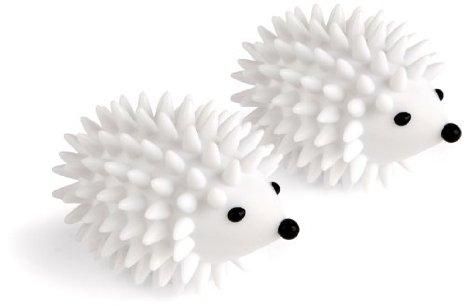The Science Behind Laundry Balls

While I was digging around in the laundry room yesterday, I came across one of those plastic spiked balls that seem to be in every household lying behind the washer. Keep in mind that these are different from dryer balls which are legitimate products.
Laundry balls like this one claim to be able to replace laundry detergent due to some poorly explained mechanism that is rarely elaborated on. They claim to save you money since laundry detergent is expensive. They also claim to be sticking it to Big Laundry or something, I don't know.
Let's break down some claims:

Laundry balls change the pH of the water to promote detergent-free cleaning. False. Unless the laundry ball has replaceable resin or some chemical that it releases that must be refilled, you will not see an appreciable pH change. Some ceramic filters can slightly change water pH, but will still be effectively neutral. We're talking about going from 7.00 to 7.02, which isn't significant.
Furthermore, changing the pH of the water would be equally helpful as it would be harmful as non-neutral pH liquids will dissolve clothes. Trust me. I used to work on industrial batteries for a living. My work clothes became pretty ragged from all of the acids and bases I'd spill on myself.
Laundry balls remove odors, germs, bacteria, or stains.
False. The laundry balls' claimed mechanism for working is mechanical agitation. Removing any of that stuff requires chemical treatment with bleach and enzymes. Laundry detergent contains numerous enzymes that are each targeted at breaking down a specific type of stain. Think proteins, carbohydrates, etc.
Reusable for thousands of loads.
True. However, this is not a particularly useful fact since it isn't doing anything in there anyway.
Lack of harmful chemicals.
True. However, it lacks any useful chemicals too.
Emits "far Infrared rays to help washing"
True and false. Everything emits infrared radiation. About 10% of heat transfer in Earth-like conditions is from infrared radiation. This does not appreciably help washing since both the clothes and the washer drum are already emitting plenty. Infrared radiation does break up surface tension in water but adding a tiny plastic ball won't add a statistically significant amount of IR.
Something something something magnets!
No .. just ... no. Water is not significantly impacted by magnetic fields of the strength you would find in a washing machine. You'd have to have a liquid helium-cooled superconductor to get anything cool going on.
Something about ions and charges.
What. If the laundry ball had an electric charge, it would be grounded out as soon as you touched it to anything. If the chemical makeup of the laundry ball contained free ions, you'd have some fairly undesirable chemical reactions going on in the wash. If there were free ions, they'd probably disassociate (think dissolve but fancy) into the water due to how Le Chatelier's principle works.
They are useful in any way, shape, form, or fashion.
Numerous studies have found that their usefulness is equal to or less than using plain water without detergent. Why worse? Well, laundry balls can break apart in the wash and cause damage to clothes and your washer drum or agitator.
Ok. Let's look at the other side. Why do we need detergent so much?
One word: Surfactants. These break up oil, grease, and dirt so that it can be washed away. Also, anti-bacterial properties kill the gunk that will make you sick and stinky. Detergent also makes use of builders to soften water by pulling minerals out of your water. As previously mentioned, bleach and enzymes both work to break up stains, remove odors, and leave your laundry smelling fresh.





Member discussion